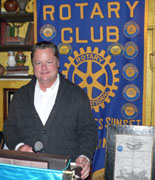Civil War and the Civil War Trust, by Jeff Dahlgren

Jeff Dahlgren, Audrey Dahlgren's son, has been interested in history for many years, due to the influence of his teacher mother. He is on the Board of Trustees for the Civil War Trust, and works with the Drum Barracks (named after a Civil War officer) and Banning House in Wilmington. (In his spare time, he is President and CEO of Airtech Advanced Materials Group, producing carbon fiber composites for aerospace and other industries.)
The Civil War Trust, of which he is now a Board Member, is a national organization with 53,000 members, many in California, dedicated to the preservation of Civil War Battlefields and the education of the public about this War. The Board meets 3 times a year. Funds come from private donors and Federal and state governments, and are used to buy selected historical pieces of land from private owners or to obtain historic easements on them, as well as for associated legal services.
Jeff displayed several Civil War artifacts, including a dart-type hand grenade and a ball hand grenade, which were packed with gunpowder and a fuse which was lit before throwing (he said they were warned never to throw it uphill!). He also displayed a long heavy infantry musket and bayonet, and a letter from a captured Confederate soldier. He showed illustrations of numerous examples of battlefields saved from development into shopping malls or residential subdivisions, and also some areas that have not been preserved and were therefore historically lost forever. (The National Park Service manages preserved battlefields.)
On the website, www.CivilWar.org, you can see Google Earth-type images and move them around to feel like you are actually there. The Teacher Institute Series is a two-week curriculum development for classrooms of primary and secondary students. There are apps on smart phones for many of the battlefields. He encourages membership applications at this website, $35 per year.
Tethered balloons for aerial battlefield reconnaissance for military commanders were developed for this war, first by the Union and then by the Confederacy. They were invented by a Prof. Lowe who developed the concept before the war, and none of them were shot down on either side.
He showed pictures of the “Soda Bottle” Cannon, invented by his ancestor, Adm. John Dahlgren, and so called because it was much larger at the breach end to prevent occasional exploding of cannons upon firing (they hate when that happens!). The first rifled cannon (having spiral internal grooves to spin the round during firing for a more accurate trajectory) were developed by the end of the war.
California was intended to be split into North and South, but the Missouri Compromise left it as a single state, associated with the North and non-slave. The San Francisco Presidio and the Drum Barracks in Wilmington were designed as Union Army Headquarters for Northern and Southern California and the then-Arizona Territory. Phineas Banning, a prominent Southern California pioneer and merchant, gave the land in Wilmington to the US government. Army expeditions patrolled the route between Wilmington and Yuma, Arizona (riding dromedary camels, which were well adapted to the desert environment), to protect from an anticipated Confederate invasion from Texas (see www.drumbarracks.org).